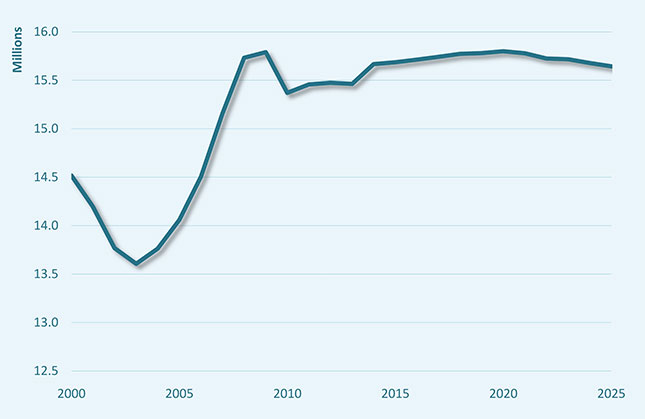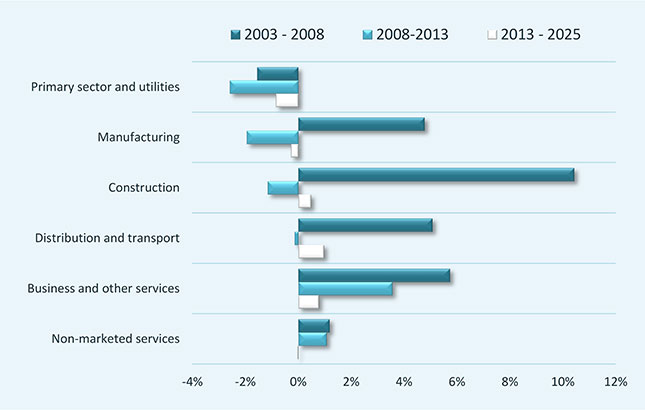
Poland: Forecast highlights
Between now and 2025:
- Employment is expected to rise slightly, but remain below its 2008 pre-crisis level.
- Most employment growth will be in the distribution and transport sector.
- Most job opportunities, around 34%, will be for professionals.
- Around 56% of the labour force will have high-level qualifications, compared to 34.7% in 2013.
Despite the economic crisis in 2008, Poland’s GDP continued to grow, averaging around 3% a year between 2008 and 2013. However, unemployment rose after 2008 and remains relatively high. In 2013, Poland’s unemployment rate was 10.2%, below the European Union (EU) average of around 11%. The European Commission forecasts GDP growth for Poland of 2.8% in 2015 and 3.3% in 2016.
Employment outlook
According to Cedefop’s skills supply and demand forecasts (see scenario assumptions), economic growth is expected to have only limited effects on job growth in Poland and employment is not expected to reach its 2008 pre-crisis level by 2025 (Figure 1). This is slower than employment growth forecast for the EU as a whole, where average employment fell in 2008 and is expected to reach its pre-crisis level in 2020.However, employment is forecast to experience slight decline by the end of the forecasting period due to the future labour force trends.

Sector developments
Although in terms of economic growth Poland withstood the financial crisis well, employment fell in the primary sector, construction and manufacturing between 2008 and 2013 (Figure 2). However, employment in business and other services and non-marketed (mainly public sector) services increased over the same period. Most future job growth in Poland will be in the distribution and transport sector, in construction and in business and other services. Employment in the primary and manufacturing sectors is forecast to fall, but jobs in non-marketed services should remain broadly stable.
 Source: Cedefop skills forecasts (2015)
Source: Cedefop skills forecasts (2015)Occupations and qualifications prospects
Cedefop’s forecasts give insights on job opportunities between now and 2025. Total job opportunities are the sum of newly created jobs (expansion demand) and job opportunities arising because of the need to replace people who either go on to other jobs or leave the labour market, for example due to retirement (replacement demand). Often, replacement demand provides more job opportunities than expansion demand, which means that there will still be job opportunities even if the overall level of employment falls. Given its ageing labour force between now and 2025, replacement demand in Poland is forecast to provide almost all job opportunities.
In Poland, most job opportunities, around 34%, will be for professionals (high level occupations in science, engineering healthcare, business and teaching), followed by around 15% for service and sales workers (Figure 3). The proportion of job opportunities forecast for professionals in Poland is much higher than the 24% forecast for the EU as a whole for this occupation.
 Source: Cedefop skills forecasts (2015)
Source: Cedefop skills forecasts (2015)Most job opportunities in Poland will require high-level qualifications (ISCED 97 levels 5 and 6) (Figure 4). However, due to replacement demand there will also be some job opportunities requiring medium-level qualifications (ISCED 97 levels 3 and 4).
 Source: Cedefop skills forecasts (2015)
Source: Cedefop skills forecasts (2015)Labour force trends
Future labour supply trends depend mainly on demographics and the size of the working-age population (defined in the forecasts as people over 15 years old), participation in the labour force (people in the working-age population either in or actively seeking work) and how quickly people acquire formal qualifications.
Eurostat’s latest population projection (Europop 2013) for Poland reflects the current trends in fertility rates and net migration flows. Poland’s working-age population is forecast to fall by up to 1% between now and 2025. Labour market participation in Poland is forecast to remain between 53% and 52% between now and 2025, below the EU forecast average of 55.5%.
Following the EU demographic trend, Poland’s population is also getting older (Figure 5). Between now and 2025, there will be a significant fall in numbers of people in the labour force of all groups except for those aged between 40 and 49 and over 65.
 Source: Cedefop skills forecasts (2015)
Source: Cedefop skills forecasts (2015)Poland’s labour force is becoming more highly qualified (Figure 6). This can be explained by older less qualified people leaving the labour market and young people staying on longer in education and training to improve their job prospects. By 2025, the share of the labour force with high-level qualifications will rise to about 56% compared to nearly 35% in 2013 and slightly over 21% in 2005. People with medium-level qualifications in 2025 will account for around 36% of the labour force, compared to 53.5% in 2013. The share with low-level or no qualifications is forecast to fall from less than 12% in 2013 to just below 8% in 2025 (Figure 6).
According to Cedefop’s forecasts, by 2020, in Poland around 67% of 30 to 34 year olds will have high level qualifications, well above the EU’s educational attainment benchmark of 40% by 2020 and the national target of 45%. On current trends around 80% of 30 to 34 year olds in Poland will have high-level qualifications by 2025.
 Source: Cedefop skills forecasts (2015)
Source: Cedefop skills forecasts (2015)In Poland, in 2013 around 5.6% of young people left the education and training system with low-level qualifications meeting the EU target of reducing this to less than 10% by 2020, but still above the national target of less than 4.5%. The EU average, in 2013, was 11.9%.
Experts’ view
Cedefop’s forecasts and their assumptions are regularly discussed with national experts. Łukasz Sienkiewicz, Assistant professor at Warsaw School of Economics and Artur Gajdos, Assistant professor at University of Lodz consider the forecasts underlying assumptions and results plausible.
They add, that underlying population projections (Europop 2013) overestimate the total population compared to national forecasts, mainly for population younger than 45. According to national experts the European Commission’s forecast slightly underestimates the future economic growth; however, its forecasts for employment trends and unemployment rates are in-line with the national forecasts.
The trend towards high-level qualifications in the labour force is possible, but depends on future employment prospects.
Cedefop skills supply and demand forecasts’ scenario
Cedefop skills supply and demand forecasts take account of global economic developments up to October 2014. Despite significant differences between countries, the forecasts generally assume that a modest economic recovery will slowly increase confidence in the EU, increasing investment, consumer spending and exports. Inflation stays in target range and interest rates low, while higher tax revenues help governments reduce debt.
The assumptions reflect the latest Eurostat population forecast (Europop 2013, published in spring 2014) and the short-term macroeconomic forecast produced by the European Commission in November 2014.
Cedefop’s forecasts use harmonised data and methodology for all countries covered to allow cross-country comparisons. They do not substitute national forecasts. Total employment data correspond to those reported in national accounts.
Cedefop’s latest skills demand and supply forecasts up to 2025 cover 28 EU Member States plus Iceland, Norway and Switzerland. Results are regularly updated and together with key assumptions and methodological developments are reviewed by national experts.
For the latest update and more detailed skills forecast data visit: www.cedefop.europa.eu/forecast



